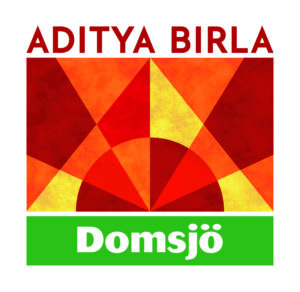Domsjö Aditya Birla
Involvement in the project
The Aditya Birla Group has been ranked fourth in the world and first in Asia Pacific in the ‘Top Companies for Leaders’ study 2011, conducted by Aon Hewitt, Fortune Magazine and RBL (a strategic HR and leadership advisory firm). The Group has topped the Nielsen’s Corporate Image Monitor 2014-15 and emerged as the ‘No.1 Corporate’, the ‘Best in Class’, for the third consecutive year.
The largest manufacturer of grey cement, white cement and concrete
The second-largest player in viscose filament yarn
The largest producer in the chlor-alkali sector
Among the top three mobile telephony companies
A leading player in life insurance and asset management
Among the top two supermarket chains in the retail business
Tony Henshaw
Chief Sustainability Officer
“We are improving our business management systems to prepare us for the transformation of our businesses to a two-degree world”
“The Aditya Birla Group endeavours to become the leading Indian conglomerate for sustainable business practices across its global operations”
This is the Aditya Birla Group Sustainability Vision set by Mr K M Birla in the year 2012 and the Group Sustainability Cell has the goal of supporting and facilitating the achievement of this vision.
Our priority is to follow the three steps of the ABG Sustainability model to help us adjust our performance to meet the ever tightening demands of a sustainable planet and society.
The first step “Responsible Stewardship” focusses on how we manage today and our goal is to building a framework of policies, technical and management standards aligned to international standards as defined by the IFC, OECD, UNGC ISO, OSHAS and many more. By introducing these standards into our systems we will manage our operations in the most responsible manner.
The second step defined by the model is to understand the external changes that will inevitably impact our companies in the future and this step of the model is called “Strategic Stakeholder Engagement”. Our goal is to build strong relationships with our stakeholders and key technical experts on climate change, water and waste management, developments in human rights legislation, safety standards, health impacts and the like. By doing so we expect to learn what are the trends that will most likely affect our businesses in the future and how are they likely to change.
The third step we will take is, “Future Proofing”, here we will embed sustainability trends into our strategic business plans to minimise the risks and find new opportunities that will be presented by the requirements of a sustainable planet and society by 2030 and 2050 and make our businesses sustainable.
All our business leaders are involved in the challenge to meet the Group’s vision and a lot of progress has already been made. Each business has created a road map to 2017 by which time we hope to be able to demonstrate that we have reached international standards of performance and have a robust plan for 2030 and beyond.
Domsjö Aditya Birla
Involvement in the project
The Company
The Aditya Birla Group has been ranked fourth in the world and first in Asia Pacific in the ‘Top Companies for Leaders’ study 2011, conducted by Aon Hewitt, Fortune Magazine and RBL (a strategic HR and leadership advisory firm). The Group has topped the Nielsen’s Corporate Image Monitor 2014-15 and emerged as the ‘No.1 Corporate’, the ‘Best in Class’, for the third consecutive year.
Businesses
The largest manufacturer of grey cement, white cement and concrete
The second-largest player in viscose filament yarn
The largest producer in the chlor-alkali sector
Among the top three mobile telephony companies
A leading player in life insurance and asset management
Among the top two supermarket chains in the retail business
Sustainability
Tony Henshaw
Chief Sustainability Officer
“We are improving our business management systems to prepare us for the transformation of our businesses to a two-degree world”
“The Aditya Birla Group endeavours to become the leading Indian conglomerate for sustainable business practices across its global operations”
This is the Aditya Birla Group Sustainability Vision set by Mr K M Birla in the year 2012 and the Group Sustainability Cell has the goal of supporting and facilitating the achievement of this vision.
Our priority is to follow the three steps of the ABG Sustainability model to help us adjust our performance to meet the ever tightening demands of a sustainable planet and society.
The first step “Responsible Stewardship” focusses on how we manage today and our goal is to building a framework of policies, technical and management standards aligned to international standards as defined by the IFC, OECD, UNGC ISO, OSHAS and many more. By introducing these standards into our systems we will manage our operations in the most responsible manner.
The second step defined by the model is to understand the external changes that will inevitably impact our companies in the future and this step of the model is called “Strategic Stakeholder Engagement”. Our goal is to build strong relationships with our stakeholders and key technical experts on climate change, water and waste management, developments in human rights legislation, safety standards, health impacts and the like. By doing so we expect to learn what are the trends that will most likely affect our businesses in the future and how are they likely to change.
The third step we will take is, “Future Proofing”, here we will embed sustainability trends into our strategic business plans to minimise the risks and find new opportunities that will be presented by the requirements of a sustainable planet and society by 2030 and 2050 and make our businesses sustainable.
All our business leaders are involved in the challenge to meet the Group’s vision and a lot of progress has already been made. Each business has created a road map to 2017 by which time we hope to be able to demonstrate that we have reached international standards of performance and have a robust plan for 2030 and beyond.

